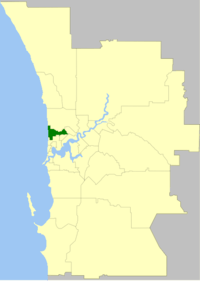Town of Cambridge
The Town of Cambridge is a local government area in the inner western suburbs of the Western Australian capital city of Perth, about 5 kilometres (3 mi) west of Perth's central business district and extending to the Indian Ocean at City Beach. The Town covers an area of 22.0 square kilometres (8.5 sq mi) and had a population of almost 27,000 as at the 2016 Census. It was originally part of the City of Perth before the restructuring by the Western Australian State Government in 1994.
| Town of Cambridge Western Australia | |||||||||||||||
|---|---|---|---|---|---|---|---|---|---|---|---|---|---|---|---|
 | |||||||||||||||
| Population |
| ||||||||||||||
| • Density | 1,217.4/km2 (3,153/sq mi) | ||||||||||||||
| Established | 1994 | ||||||||||||||
| Area | 22.0 km2 (8.5 sq mi) | ||||||||||||||
| Mayor | Keri Shannon | ||||||||||||||
| Council seat | Floreat | ||||||||||||||
| Region | Inner Metropolitan Perth | ||||||||||||||
| State electorate(s) | Churchlands, Nedlands | ||||||||||||||
| Federal Division(s) | Curtin | ||||||||||||||
 | |||||||||||||||
| Website | Town of Cambridge | ||||||||||||||
| |||||||||||||||
History
Historically the area was part of the North Perth municipality, gazetted in 1901, which was absorbed into the City of Perth in 1915 after becoming unsustainable as an autonomous political entity. In 1993 the Government of Western Australia decided to split up the local government area (LGA) of the City of Perth, creating three additional LGAs and retaining a smaller City of Perth. The new LGAs were Town of Vincent, Town of Cambridge and the Town of Victoria Park.[3]
Parks and reserves
Cambridge has many parks and reserves.[4] The Town has two major reserves, Lake Monger and Perry Lakes, as well as 4.8 km of coastline, including City Beach and Floreat Beach and their respective parks, and the nearby dunes.
Wards
The city has been divided into 2 wards, each electing 4 councillors.
- Coast Ward
- Wembley Ward
Suburbs
(* indicates suburb only partially located within Town)
Population
| Year | Population |
|---|---|
| 1991 | 22,740 |
| 1996 | 22,706 |
| 2001 | 22,859 |
| 2006 | 23,753 |
| 2011 | 24,965 |
| 2016 | 26,783 |
Heritage listed places
As of 2020, 134 places are heritage-listed in the Town of Cambridge,[5] of which eleven are on the State Register of Heritage Places, among them the Model Brick Home and Model Timber Home.[6]
References
- Australian Bureau of Statistics (27 June 2017). "Cambridge (T)". 2016 Census QuickStats. Retrieved 26 November 2017.

- "3218.0 – Regional Population Growth, Australia, 2017-18". Australian Bureau of Statistics. 27 March 2019. Retrieved 31 December 2019. Estimated resident population (ERP) at 30 June 2018.
- WA Electoral Commission, Municipality Boundary Amendments Register (release 3.0), 31 May 2007.
- Town of Cambridge (26 March 2007). "Parks, Playgrounds, Barbecues". Archived from the original on 22 April 2007. Retrieved 22 April 2007.
- "Town of Cambridge Heritage Places". inherit.stateheritage.wa.gov.au. Heritage Council of Western Australia. Retrieved 29 April 2020.
- "Town of Cambridge State Register of Heritage Places". inherit.stateheritage.wa.gov.au. Heritage Council of Western Australia. Retrieved 29 April 2020.